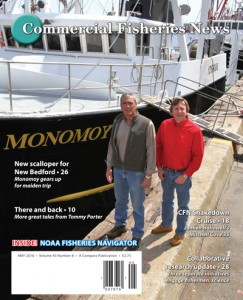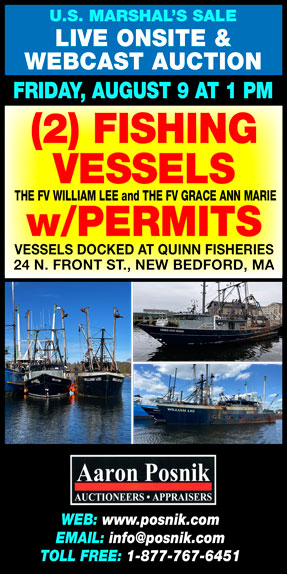Due to draconian quota reductions on groundfish in the Northeast, as we all know, many local fishing vessels have shifted their fishing grounds logistically to the south and southwest in recent years.
From 2010 through present times, many vessels have bought landing permits for New Jersey, Virginia, and North Carolina – allowing them access to quota species there such as scup, black sea bass, croaker, and most notably summer flounder.

A qualified Coast Guard-approved marine drill instructor, Fred Mattera of Point Judith, RI is the owner/president of North East Safety Training Co. (NESTCo), which conducts fishing vessel drills and inspections and basic safety training workshops.
A commercial fisherman for 40 years, Mattera is a member of the Commercial Fishing Safety Advisory Committee to the Coast Guard, and, since 1998, has been president of the Point Club, a fishing vessel mutual insurance group. He also has served on the board of directors for Sunderland Marine Mutual Insurance Co., the principal underwriter for the Point Club and more than 2,000 US fishing vessels, since 1998.
These species are harvested offshore (outside 20 miles) from October to April and landed in the states of their respective permits.
Captains I talk to have openly voiced concerns of landing in ports that they have never been to in the past.
Some local boats are now steaming many miles through unfamiliar inlets and bays, relying on a buoyage system and navigational waters that they are not familiar with.
This has prompted me to provide a review of the buoys, colors, numbers, shapes and lights of the buoyage system in navigable waters.
The basic structure of this system is called the lateral system and is based upon channels determined as “proceeding from seaward,” in which vessels returning from sea are to leave red markers to the starboard side (as in the saying, “red right returning”).
The term “proceeding from seaward” means following the Atlantic coast in a southerly direction.
Navigable waters are defined as coastal waters that include bays, sounds, inlets, and rivers that are navigable from the sea.
Certain buoys and daymarks have differentiated shapes and some are painted distinctive colors to indicate, both of which tell you on which side to leave the buoy. Numbers and letters further identify the individual buoys.
In this system, buoys that mark the sides of channels have numbers which increase when proceeding from seaward.
Buoys:
Buoys are floating objects anchored to the bottom at specific locations so as to function as aids to navigation. They may be lighted or unlighted, with a visual signal of definite color and flashing pattern. There are also sound buoys and both light and sound buoys.
Buoys are depicted on charts by various symbols and abbreviations that indicate the type, color, numbering, and visual or sound signals. Remember, the actual size of buoy is not shown on a chart.
Day beacons:
Day beacons are unlighted fixed structures in shallow waters or on shore. They consist of a simple structure of a single pile of wood, concrete, metal or a dolphin.
On the structure are sign boards called day markers to convey navigational information. Day markers can be identified by shape and color with navigational significance. They are covered with reflective material and retro-reflective borders which make them easy to locate at night with a searchlight.
Square day markers are used the same as green can buoys to mark the port side of the channel.
Triangular day markers are used the same as red nun buoys to mark the starboard side of the channel.
Preferred channel day markers can be square or triangle to mark junctions in channel, wrecks and obstructions. The shape and color of the top-half of day marker indicate the preferred channel.
Octagonal-shaped day markers are used to mark the fairway or middle of the channel. These day markers will be vertically divided, half red or black and half white.
Day marker numbers and letters are the same as on buoys. The numbers are white and reflective to be identifiable at night by searchlight.
Shapes:
In order to provide quick identification, certain unlighted buoys are different in shape.
- Can buoys are cylindrical. The upper part of the cylindrical shape may consist of two metal plates at right angles to each other, they serve as radar reflectors without changing the appearance of the buoy from a distance.
- Nun buoys consist of shorter cylinders topped with blunted conical caps or metal plates that give the conical appearance at a distance.
- Safe water buoys marking mid-channels are spherical, with spherical topmarks.
- Isolated danger buoys are moored over or placed immediately adjacent to an isolated danger which may be passed safely on all sides. This buoy is colored black with one broad horizontal red band. Any shape except nun or spherical. The topmark for this is two vertical black balls and the marks must be lettered, with the first character the letter “D.”
Colors:
Buoys are colored red, green, or a combination of red and green.
Green buoys mark the port (left) side of the channel when “proceeding from seaward,” or the location of wrecks or obstructions that must be passed by keeping the buoy on the portside of the vessel when proceeding from seaward.
Red buoys mark the starboard (right) side of the channel or location of wrecks and obstructions that must be passed on the starboard side of the vessel, proceeding from seaward. Red right returning.
Junction buoys are green with a wide red horizontal band or red with a wide horizontal green band. The topmost color indicates the preferred side of the channel.
Mid-channel or fairway buoys are red and white vertically striped. They are “safe water” aids to navigation and can be passed close by on either side.
Numbers:
Most buoys, day beacons, and minor lights used on navigable waters have numbers, letters, or a combination of both placed conspicuously on the buoys. These markings are made of reflective material to help identify the buoy.
Odd numbers are only used on solid green buoys/aids.
Even numbers are used only on solid red buoys/aids.
Letters may be required with a number, so as not to disturb the sequence of the numbering, but to indicate some other significance such as a particular shoal. Letters usually mark junctions and mid-channel buoys.
Day markers that are used in place of buoys are numbered and lettered in the same manner as buoys.
Lighted buoys:
Some or all of the buoys you encounter may be equipped with lights in an area where there is significant night time traffic on the water.
Green lights on solid green buoys mark the port side of the channel.
Red lights on solid red buoys mark the starboard side of the channel.
Lights corresponding with the top mast color are used for the preferred channel buoy.
White lights are used on mid-channel or fairway buoys.
Yellow lights are used on special purpose buoys.
Lights on red and green buoys will always be flashing, occulting, or quick flashing.
Flashing lights flash at the rate of 50 or fewer flashes per minute. In a flashing light the light is off more than it is on. Episodes of darkness are interrupted by short flashes of light.
Occulting light is on longer than it is off. This light is steady with interrupted short eclipses of darkness.
Quick-flashing lights have a distinct cautionary significance, such as sharp turns or a sudden constriction in the channel, or to mark wrecks or hazardous obstructions which can be passed safely on one side only. The frequency of flashes will be at a rate of 50-80 or more per minute.
Although buoys can be invaluable aids to navigation, their lights may extinguish, they can shift location or capsize, and they may be carried away by the tide, ice, or even a vessel.
If buoys don’t appear to be where the chart indicates, they just may not be there.
BEWARE!
Remember: prudent mariners never rely on a single source for navigational information.

To get more stories you’ll need the MAY 2016 issue of Commercial Fisheries News.
Please choose from the following options:
BUY a Single PRINT edition of CFN that is delivered by MAIL. PRINT EDITION
Quickly enjoy ONLINE access with our Hi-DEF flip-book. PURCHASE ONLINE EDITION
(Read online flip-book immediately with purchased access key and download a copy for yourself to keep. Not sure if it works for you? Try a FREE SAMPLE HERE.)
SAVE BIG when you SUBSCRIBE!







